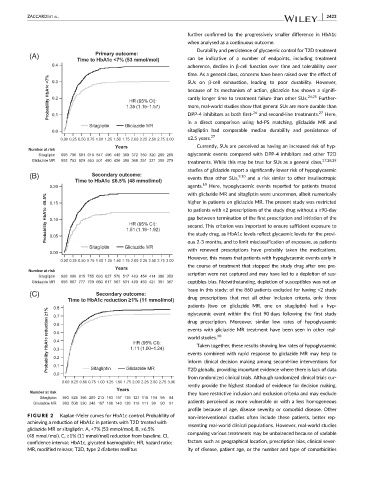Page 68 - Diamicron MR MIG Cycle 2(20-21) Final
P. 68
ZACCARDI ET AL. 2423
further confirmed by the progressively smaller difference in HbA1c
when analysed as a continuous outcome.
Durability and persistence of glycaemic control for T2D treatment
(A) can be indicative of a number of endpoints, including treatment
adherence, decline in β-cell function over time and tolerability over
time. As a general class, concerns have been raised over the effect of
SUs on β-cell exhaustion, leading to poor durability. However,
because of its mechanism of action, gliclazide has shown a signifi-
cantly longer time to treatment failure than other SUs. 24,25 Further-
more, real-world studies show that general SUs are more durable than
DPP-4 inhibitors as both first- 26 and second-line treatments. 27 Here,
in a direct comparison using hd-PS matching, gliclazide MR and
sitagliptin had comparable median durability and persistence of
≥2.5 years. 27
Currently, SUs are perceived as having an increased risk of hyp-
oglycaemic events compared with DPP-4 inhibitors and other T2D
treatments. While this may be true for SUs as a general class, 17,28,29
studies of gliclazide report a significantly lower risk of hypoglycaemic
(B) events than other SUs, 9,10 and a risk similar to other insulinotropic
agents. 10 Here, hypoglycaemic events reported for patients treated
with gliclazide MR and sitagliptin were uncommon, albeit numerically
higher in patients on gliclazide MR. The present study was restricted
to patients with ≥2 prescriptions of the study drug without a ≥90-day
gap between termination of the first prescription and initiation of the
second. This criterion was important to ensure sufficient exposure to
the study drug, as HbA1c levels reflect glycaemic levels for the previ-
ous 2-3 months, and to limit misclassification of exposure, as patients
with renewed prescriptions have probably taken the medications.
However, this means that patients with hypoglycaemic events early in
the course of treatment that stopped the study drug after one pre-
scription were not captured and may have led to a depletion of sus-
ceptibles bias. Notwithstanding, depletion of susceptibles was not an
issue in this study: of the 860 patients excluded for having <2 study
(C)
drug prescriptions that met all other inclusion criteria, only three
patients (two on gliclazide MR, one on sitagliptin) had a hyp-
oglycaemic event within the first 90 days following the first study
drug prescription. Moreover, similar low rates of hypoglycaemic
events with gliclazide MR treatment have been seen in other real-
world studies. 30
Taken together, these results showing low rates of hypoglycaemic
events combined with rapid response to gliclazide MR may help to
inform clinical decision making among second-line interventions for
T2D globally, providing important evidence where there is lack of data
from randomized clinical trials. Although randomized clinical trials cur-
rently provide the highest standard of evidence for decision making,
they have restrictive inclusion and exclusion criteria and may exclude
patients perceived as more vulnerable or with a less homogeneous
profile because of age, disease severity or comorbid disease. Other
FIGURE 2 Kaplan-Meier curves for HbA1c control. Probability of non-interventional studies often include these patients, better rep-
achieving a reduction of HbA1c in patients with T2D treated with resenting real-world clinical populations. However, real-world studies
gliclazide MR or sitagliptin. A, <7% (53 mmol/mol). B, ≤6.5%
(48 mmol/mol). C, ≥1% (11 mmol/mol) reduction from baseline. CI, comparing various treatments may be unbalanced because of variable
confidence interval; HbA1c, glycated haemoglobin; HR, hazard ratio; factors such as geographical location, prescription bias, clinical sever-
MR, modified release; T2D, type 2 diabetes mellitus ity of disease, patient age, or the number and type of comorbidities

